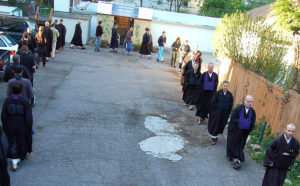One foundational aspect of Zen training is to engage in particular customs, or forms of practice, as a way to cultivate mindful presence as well as to harmonize with one another in our shared endeavor to awaken. Through these forms we encourage stillness of body and mind, within and without, to help us most deeply encounter and embrace our lives in each moment. Please do not worry about getting them “right.” We have a gentle, accommodating approach.
These “forms,” or standards of deportment, are intended to support us in waking up to our inherently wise and compassionate nature (as well as to other people and even to inanimate objects). Forms manifest as particular ways in which we sit, stand, walk, eat, chant, bow, as well as how we as practitioners interact with one another and with the Dharma. When first beginning Zen practice, the forms can seem like an endless array of “rules”: stand this way, turn that way, don’t put your hands in your pockets, straighten up, don’t move your cushion with your foot, don’t eat while standing up; when to bow, when not to bow; and on and on. It is common for new students to experience a wide range of feelings and reactions when practicing new forms– from confusion or frustration to self-aggrandizement and conceit! Whatever the experience, training in the forms provides a rare opportunity to directly encounter our own minds with the wisdom and compassion we cultivate in our meditation: open awareness without judgment.
As there are countless misunderstandings that can come up about forms, a lot of time and energy is spent demonstrating, explaining and reviewing students’ use of them.








